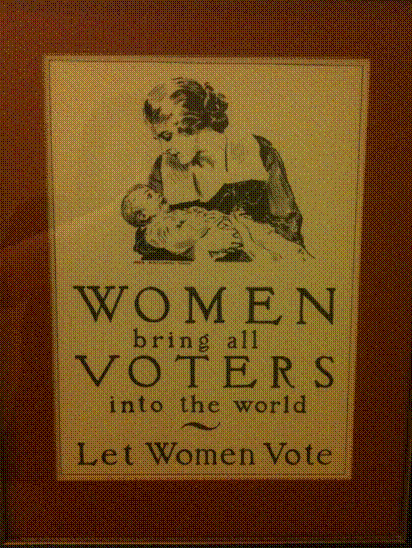
August 26, 1920: Women win right to vote
By Jone Johnson Lewis
Votes for women were first seriously proposed in the United States in July, 1848, at the Seneca Falls Woman’s Rights Convention organized by Elizabeth Cady Stanton and Lucretia Mott. One woman who attended that convention was Charlotte Woodward. She was nineteen at the time. In 1920, when women finally won the vote throughout the nation, Charlotte Woodward was the only participant in the 1848 Convention who was still alive to be able to vote, though she was apparently too ill to actually cast a ballot.
Some battles for woman suffrage were won state-by-state by the early 20th century. Alice Paul and the National Women’s Party began using more radical tactics to work for a federal suffrage amendment to the Constitution: picketing the White House, staging large suffrage marches and demonstrations, going to jail. Thousands of ordinary women took part in these — a family legend is that my grandmother was one of a number of women who chained themselves to a courthouse door in Minneapolis during this period.
In 1913, Paul led a march of eight thousand participants on President Woodrow Wilson’s inauguration day. (Half a million spectators watched; two hundred were injured in the violence that broke out.) During Wilson’s second inaugural in 1917, Paul led a march around the White House.
Opposed by a well-organized and well-funded anti-suffrage movement which argued that most women really didn’t want the vote, and they were probably not qualified to exercise it anyway, women also used humor as a tactic. In 1915, writer Alice Duer Miller wrote,
Why We Don’t Want Men to Vote
- Because man’s place is in the army.
- Because no really manly man wants to settle any question otherwise than by fighting about it.
- Because if men should adopt peaceable methods women will no longer look up to them.
- Because men will lose their charm if they step out of their natural sphere and interest themselves in other matters than feats of arms, uniforms, and drums.
- Because men are too emotional to vote. Their conduct at baseball games and political conventions shows this, while their innate tendency to appeal to force renders them unfit for government.
During World War I, women took up jobs in factories to support the war, as well as taking more active roles in the war than in previous wars. After the war, even the more restrained National American Woman Suffrage Association, headed by Carrie Chapman Catt, took many opportunities to remind the President, and the Congress, that women’s war work should be rewarded with recognition of their political equality. Wilson responded by beginning to support woman suffrage. In a speech on September 18, 1918, he said,
We have made partners of the women in this war. Shall we admit them only to a partnership of suffering and sacrifice and toil and not to a partnership of right?
Less than a year later, the House of Representatives passed, in a 304 to 90 vote, a proposed Amendment to the Constitution:
The right of citizens of the United States to vote shall not be denied or abridged by the United States or by any States on Account of sex. The Congress shall have the power by appropriate legislation to enforce the provisions of this article.
On June 4, 1919, the United States Senate also endorsed the Amendment, voting 56 to 25, and sending the amendment to the states.
Illinois, Wisconsin and Michigan were the first states to pass the law; Georgia and Alabama rushed to pass rejections. The anti-suffrage forces, which included both men and women, were well-organized, and passage of the amendment was not easy.
When thirty-five of the necessary thirty-six states had ratified the amendment, the battle came to Nashville, Tennessee. Anti-suffrage and pro-suffrage forces from around the nation descended on the town. And on August 18, 1920, the final vote was scheduled.
One young legislator, 24-year-old Harry Burn, had voted with the anti-suffrage forces to that time. But his mother had urged that he vote for the amendment and for suffrage. When he saw that the vote was very close, and with his anti-suffrage vote would be tied 48 to 48, he decided to vote as his mother had urged him: for the right of women to vote. And so on August 18, 1920, Tennessee became the 36th and deciding state to ratify.
Except that the anti-suffrage forces used parliamentary maneuvers to delay, trying to convert some of the pro-suffrage votes to their side. But eventually their tactics failed, and the governor sent the required notification of the ratification to Washington, D.C.
And so on August 26, 1920, the Nineteenth Amendment to the United States Constitution became law, and women could vote in the fall elections, including in the Presidential election.
(From About.com)

